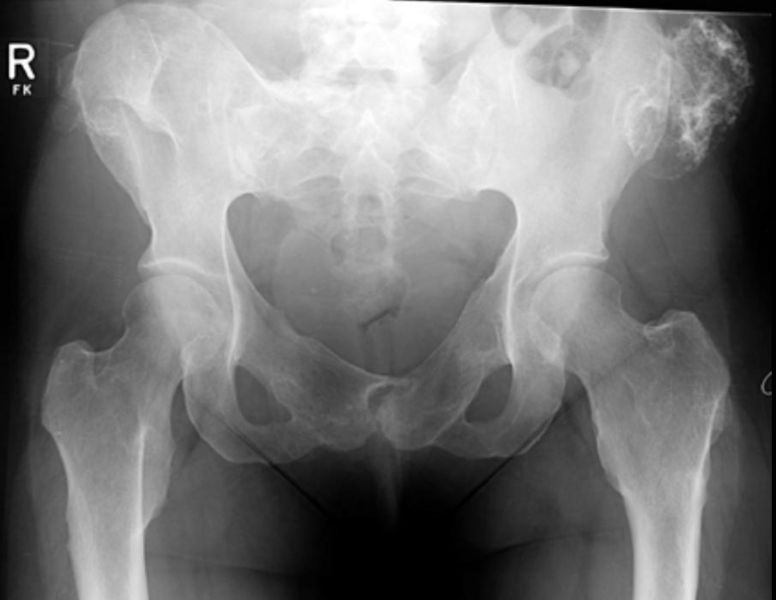Hereditary multiple exostoses
| Hereditary multiple exostoses | |
| ICD-10 | Q78.6 |
|---|---|
| OMIM | 133700 133701 |
| DiseasesDB | 33342 |
| MeSH | D005097 |
Editor-In-Chief: C. Michael Gibson, M.S., M.D. [1]
Overview
Hereditary multiple exostoses (HME) is a rare medical condition in which multiple bony spurs or lumps (also known as exostoses, or osteochondromas) develop on the bones of a child. HME is synonymous with Multiple hereditary exostoses and Multiple osteochondromatosis, which is the preferred term used by the World Health Organization.
Pathophysiology
HME is estimated to occur in 1 in 50,000 people. It is characterized by the growth of cartilage-capped benign bone tumours around areas of active bone growth, particularly the metaphysis of the long bones. HME can lead to the shortening and bowing of bones, as such affected individuals often have a short stature. Depending on their location the exostoses can cause the following problems: pain or numbness from nerve compression, vascular compromise, inequality of limb length, irritation of tendon and muscle, as well as a limited range of motion at the joints upon which they encroach. Generally, when a person with HME reaches maturity, and their bones stop growing, the exostoses also stop growing. A person with HME is also more likely to develop a rare form of bone cancer called chondrosarcoma as an adult. [1][2][3]
Treatment
HME begins to manifest itself in childhood and currently has no cure. Surgery, physical therapy and pain management are currently the only options available to HME patients, but success varies from patient to patient and many struggle with pain, fatigue and mobility problems throughout their lives. It is not uncommon for HME patients to undergo numerous surgical procedures throughout their lives to remove painful or deforming exostoses, correct limb length discrepancies or improve range of motion.[2][4]
Genetics
HME is an autosomal dominant hereditary disorder. This means that a patient with HME has a 50% chance of transmitting this disorder to his or her children. Most individuals with HME have a parent who also has the condition, however, approximately 10% -20% of individuals with HME have the condition as a result of a spontaneous mutation and are thus the first person in their family to be affected.
HME has thus far been linked with mutations in three genes. EXT1 which maps to chromosome 8q24.1 [5], EXT2 which maps to 11p13[6], and EXT3 which maps to the short arm of Chromosome 19 (though its exact location has yet to be precisely determined).[7] Mutations in these genes typically lead to the synthesis of a truncated EXT protein which does not function normally. It is known that EXT proteins are important enzymes in the synthesis of heparan sulfate, however the exact mechanism by which altered synthesis of heparan sulfate could lead to the abnormal bone growth associated with HME is unclear. It is thought that normal chondrocyte proliferation and differentiation may be affected, leading to abnormal bone growth. [8][9]
For individuals with HME who are considering starting a family, preimplantation genetic testing and prenatal diagnosis are available to determine if their unborn child has inherited the disease. HME has a 96% penetrance, which means that if the disease is indeed transmitted to a child, he/she will have a 96% of actually manifesting the disease, and 4% chance of having the disease but never manifesting it.
Patient #1
Patient #2
References
- ↑ CANNON JF (1954). "Hereditary multiple exostoses". American Journal of Human Genetics. 6 (4): 419–25. PMID 14349947.
- ↑ 2.0 2.1 McBride WZ (1988). "Hereditary multiple exostoses". American family physician. 38 (3): 191–2. PMID 3046271.
- ↑ Schmale GA, Conrad EU, Raskind WH (1994). "The natural history of hereditary multiple exostoses". The Journal of bone and joint surgery. American volume. 76 (7): 986–92. PMID 8027127.
- ↑ Morrissy R.T. and Weistein S.L. Lovell and Winter's pediatric orthopaedics, Volume 1, 5th ed., Lippincott Williams & Wilkins, Philidelphia, 2001; pp.274-275. ISBN:0781725828
- ↑ Cook A, Raskind W, Blanton SH, Pauli RM, Gregg RG, Francomano CA, Puffenberger E, Conrad EU, Schmale G, Schellenberg G (1993). "Genetic heterogeneity in families with hereditary multiple exostoses". American Journal of Medical Genetics. 53 (1): 71–9. PMID 8317501.
- ↑ Wu YQ, Heutink P, de Vries BB, Sandkuijl LA, van den Ouweland AM, Niermeijer MF, Galjaard H, Reyniers E, Willems PJ, Halley DJ (1994). "Assignment of a second locus for multiple exostoses to the pericentromeric region of chromosome 11". Human Molecular Genetics. 3 (1): 167–71. PMID 8162019.
- ↑ Le Merrer M, Legeai-Mallet L, Jeannin PM, Horsthemke B, Schinzel A, Plauchu H, Toutain A, Achard F, Munnich A, Maroteaux P (1994). "A gene for hereditary multiple exostoses maps to chromosome 19p". Human Molecular Genetics. 3 (5): 717–22. PMID 8081357.
- ↑ Zak BM, Crawford BE, Esko JD (2002). "Hereditary multiple exostoses and heparan sulfate polymerization". Biochimica Biophysica et Acta. 1573 (3): 346–55. PMID 12417417.
- ↑ Stieber JR, Dormans JP (2005). "Manifestations of hereditary multiple exostoses". The Journal of the American Academy of Orthopaedic Surgeons. 13 (2): 110–20. PMID 15850368.
External links
- Hereditary Multiple Exostoses Research Foundation's Website
- Medcyclopaedia - Hereditary Multiple Exostises
- GeneReviews: Hereditary Multiple Exostoses



